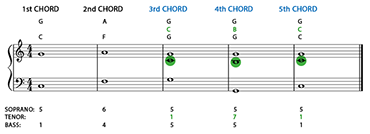
HOSTS- Jeremy Burns, Matthew Scott Phillips
TYPE- Ear Training
DURATION- 30:11
BUMPER MUSIC- "Progression 145" (Area 47 Music)
"Progression 1245" (Area 47 Music)
ANNOUNCER- Mike Cunliffe
Harmonic dictation is an essential part of the music students curriculum. It can be a powerful tool for any musician because it will help to solidify an understanding of harmony and harmonic progression. In this episode, we will give tips and strategies to on how to hear those harmonies and pass that listening exam! This episode will feature the diatonic chords (in major) I, ii, IV and V.

On average, you may be given between 3 and 5 listens to identify a chord progression. Below is a good strategy on how to use your listens wisely for each time the progression is played. We will use 4 listens for this approach. At the top of the graphic, you will see the note LETTER names. At the bottom, the notes will be represented as
SCALE DEGREES.
1st LISTEN-THE BASS
Use this listen to focus on the bass line. In our first example, we hear the following scale steps in the bass:
1 - 4 - 5 - 5 - 1
Notate it!

2nd LISTEN-THE HIGHEST NOTE
Use this listen to focus on the melody or the soprano voice. When you hear that note, try to identify what scale degree it is and where it goes from there. Sometimes singing (in your head), from the identified note down to the the tonic, can help zero in on what scale degree it is. In this case, we hear that scale degree 5 begins the following progression in the highest voice:
5 - 6 - 5 - 5 - 5
Notate it!

3rd LISTEN-THE THEORY BRAIN
Something harmonic is coming together! We now have enough information to ENGAGE OUR THEORY BRAIN and start making educated guesses at how this progression might develop. Here's an example of the process:
1st CHORD
-I hear scale degrees 1 (bass) and 5 (melody).
-Both of these notes are in the tonic (I) chord.
-We are in a MAJOR key and this is sounds like a MAJOR chord.
-The tonic chord is always the same quality as the key its in.
Let's call this the I chord and see how that works!
2nd CHORD
-I hear scale degrees 4 (bass) and 6 (melody).
-Both of these notes are in the sub dominant (IV) chord. HOWEVER, both of these notes are also in the SUPER TONIC (ii) chord. In the IV chord, that scale degree 4 would be the root. In the ii chord in 1st inversion, that scale degree 4 would be the 3rd.
-We are in a MAJOR key and this is sounds like a MAJOR chord.
-In MAJOR, the IV chord is MAJOR and the ii chord is MINOR. So, it can't be the ii chord.
Let's call this the IV chord for now and try to listen for a confirmation that it's major next time around.
3rd CHORD
-I hear scale degrees 5 (bass) and 5 (melody).
-For both of these notes to be the 5th scale degree, one might jump to the conclusion that this must be the DOMINANT (V) chord (consisting of scale degrees: 5, 7 and 2). HOWEVER, this could also easily be a TONIC (I) chord (consisting of scale degrees: 1,3 and 5) in 2nd inversion, with the 5th in the bass voice.
-We are in a MAJOR key and this is sounds like a MAJOR chord. HOWEVER, both the I and V chords are MAJOR in said key.
-This example contains a telltale element that solves the issue and it involves the surrounding chords and how they work together:
-Listen carefully to the 3rd, 4th and 5th chords
and you will hear scale degrees 1, 7, and 1
(in that order) occurring in one of the middle
voices (the TENOR voice in this case)

The note sequence 1 - 7 - 1 is a good indicator
of the I - V - I chord progression. In this case,
that's exactly what is happening. This especially
becomes evident when you fill in that tenor voice. That tenor voice is on the C note, the
tonic. The tonic note is not in the V chord.
Let's mark this as a I chord!
4th CHORD
-We have the same dilemma as when listening to the 3rd chord in the progression; scale degree 5 in the lowest AND highest voices.
-However, the scale degree 7 in this chord resolves to the tonic (in the following chord). This is typical of a V - ! progression.
-Scale degree 7 does NOT belong the I chord.
This is starting to feel like a V chord.
5th CHORD
-We have scale degrees 1 (bass) and 5 (soprano).
-We also now know that scale degree 1 is in the tenor voice.
-Using the same logic we used in the 1st chord in this progression, we can determine that is the TONIC (I) chord.
This is shaping up to be a I - IV - I6/4 - V - I
4th LISTEN-CONFIRMATION
Ideally, this listen will be your confirmation listen. Check out all the voices you filled in and make sure they make sense with what you're hearing. Fill in that other middle voice (the ALTO in this case), if you haven't already. By the time you have a majority of at least 3 of the 4 voices, the 4th one can be filled in with relative ease if we use our
THEORY BRAIN.
Here's what it will look like.

NOW LISTEN AS WE APPLY THIS APPROACH TO THE NEXT EXAMPLE
-When trying to determine which scale degree is in the highest voice, try singing down the scale from that note. If you feel you've reached the TONIC on the 3rd note down, that note is the 3rd.
-When trying to determine a ii chord from a IV chord, listen for a certain richness or an emotive appeal. This occurs because the ii chord is minor in the major keys so it stands out more.
-Try practicing progressions using these 4 chords (I,ii,IV and V) using CHORALE or KEYBOARD styles.
-Try to get good at singing "in your head" or to your self. When you hear a chord, try to arpeggiate the notes in your head.
-Try to get good at identifying the bass lines when listening to music. These will be the first that you will want to identify when taking your listening exams.
-Budget your listens wisely. First identify the lowest notes. Second, identify the highest notes. Use the 3rd listen to engage your theory brain and then the fourth to confirm.
